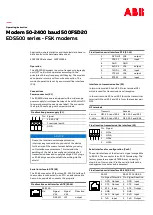
MULTI STANDARD INTERFACE
P1440A
1998
PARADISE DATACOM
S/N
1097
This text so coreldraw doesn’t crash on export !
This text so coreldraw doesn’t crash on export !
ESC, AUX &
BACKWARD
ALARMS
IN
OUT
E1
75R
Tx IF
Rx IF
STATION CLOCK
REMOTE M&C
1 FOR 1
ALARMS & AGC
ASYNC ESC
100-240Vac
0.3-0.1A
50/60Hz
P300H
P300 Modem Installation and Operating Handbook
Page 18
P300 Modem rear panel view (IDR & G.703 options fitted)
3.5
REAR PANEL DESCRIPTION
At the rear of unit are all of the connectors necessary for the user to interface the Modem to the outside
world; IF input and output to frequency conversion equipment, terrestrial data connection, station clock,
alarms & AGC output, remote M&C, AC power and so on.
From left to right, the rear panel connectors are:
IEC mains power connector/voltage selector/fuse
The Modem is designed to operate from a mains AC supply of 100-240V (-15% + 10%, ie 85V to 264V at
the connector). The IEC connector incorporates two fuses, independently fusing both live and neutral lines.
Access to the fuses are provided by a slide out tray. Both fuses are standard 20 mm type, rated 2A, of the
slow-blow (time delay) type. ALWAYS REPLACE THE FUSE WITH ONE OF THE SAME TYPE AND
RATING.
Chassis ground stud
This is an M4 stud for connecting a safety earth conductor directly to the chassis of the unit.
Fan
The fan may be selected to be temperature controlled or permanently active (ie the fact that it is not running
does not indicate it has failed). Use the test menu to display the internal unit temperature if in doubt, the
fan comes on at 26
(
C and off at 24
(
C.
Station Clock
This connector is a 75
6
BNC female which accepts a 1-10MHz signal, either a square wave of >1V p/p
(eg a G.703 para 10 `synchronising clock`) or a sinusoid at a power level of 0dBm or greater. An alternative
Station Clock signal at RS422 interface levels can be applied to the Async ESC connector. Either signal
can be used by the modem as a reference for the receive output clock (the Station Clock does not have
to be the same rate as the data as an internal PLL converts between rates). In addition if the Rx Clocking
is set to use the “Station Clock” and the Tx Clocking is set to “Rx”, then the Station Clock also sources the
internally generated Tx Clock (Tx & Rx data rates are independent). Finally, if a 10MHz signal is applied,
this signal may also be used in place of the internal 1PPM reference for the Tx and Rx IF synthesisers.
1:1 Redundancy connector
The Modem has a built-in 1 for 1 redundancy controller which connects to the corresponding port of
another Modem via this 9 pin male 'D' type connector. A complete 1:1 redundancy system requires only
two modems, a 1:1 control cable (on this port), a data split (`Y`) cable, and passive splitters/combiners for
the IF ports (or splitters/combiners already present in the system). Connection details are given in
Appendix B, and an overview of 1 for 1 operation is provided in section 9 starting on page 152.
Remote M&C connector
This is a 9 pin female 'D' type connector whose pinout and interface levels are `SA-bus` compliant. The
Modem can be set to operate with either Paradise/FDC or SA-bus protocols. The electrical interface can
be selected between RS232 (for direct to PC applications) & RS485 (for multidrop applications). The
Remote M&C port may be
internally
linked (ie no cables) to the Async ESC port for over the satellite distant
end Remote M&C control. Pinout details are in Appendix B.
















































